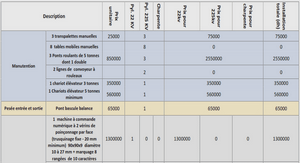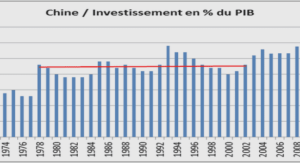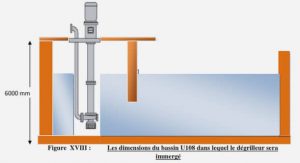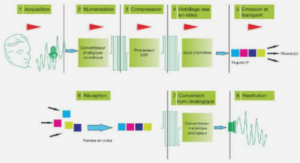Télécharger le fichier original (Mémoire de fin d’études)
Electromagnetic radiation
Radiation representation
The electromagnetic radiation or the electromagnetic wave is a form of energy propagated through space or medium by the periodic vibration of electric and magnetic fields. The propagation direction is always perpendicular to the vibration direction (transverse wave). The radiation in radiative transfer calculations is often represented by the monochromatic plane wave, which is more or less true if the radiation is far from the source or the scatterer. The electric field vector of a monochromatic plane wave propagating in direction ̂ = ̂ × ̂ can be represented as the sum of two orthogonal complex vectors ̂ and ̂ (Eq. (1.1)) vibrated in the plane transverse to ̂ . In our definition, is perpendicular to the meridional plane and is in the meridional plane (Figure 1.1). Usually, and are defined as the horizontal and the vertical oscillation component, respectively.
Although the electromagnetic radiation has wave and quantum properties, an important point is to know when it should be viewed as wave or as photons. Usually, the wave property matters when considering medium and surface scattering, and the quanta property matters when considering the emission and absorption by individual atoms or molecules. Sometimes, the property point of view does not matter, such as when comping the radiant energy.
Polarization and Stokes vector
The transverse wave property is well adapted to inform about the polarization state of the radiation. The geometrical orientation of the oscillation can be any direction perpendicular to the propagation direction. The polarization state is often represented by a column of four real quantities = [ , , , ]T (unit: W/m2) known as the Stokes vector. is the radiation intensity. is the horizontal/perpendicular (+) or vertical/parallel (–) polarization. is the 45° (+) and 135° (–) diagonal polarization, with the angle counted anticlockwise starting from ̂ . is the clockwise (+) and anticlockwise (–) circular polarization (Lee and Pottier, 2017). The Stokes vector of the monochromatic plane wave is computed in Eq. (1.2), with the permittivity and the permeability, = − is the initial phase difference.
Electromagnetic spectrum
Frequency is the most fundamental characteristic of a harmonic electromagnetic field. It is constant until the radiation is absorbed or converted to another form of energy. In radiative transfer calculations, it is more convenient to use the wavelength rather than the frequency , because the frequencies of interest to Earth observation tend to be numerically large and unwieldy. The two parameters are related by Eq. ((1.5)) in which = 0/ is the speed of light in a medium with refractive index , and 0 = 299792458 m/s is the speed of light in vacuum. The corresponding wavelength in vacuum is 0 = 0/ = .
The electromagnetic spectrum spans a wide range of frequencies, from zero to very high frequencies associated to energetic photons released by nuclear reactions. For practical reasons, scientists and engineers subdivided the spectrum into a few discrete spectral domains, and it exists different definitions of discrete spectral domains in literature. Table 1.1 shows the spectral domains commonly used for vegetation studies.
Radiometric quantities
Any radiation transports energy. Considering the wave nature of radiation, the Poynting vector gives the instantaneous direction and magnitude of the transported energy. For the harmonic wave, we are interested in the average energy over one complete cycle. This is the intensity [W/m2] of the radiation incident onto a unit area perpendicular to the propagation direction. It is proportional to the square of the scalar amplitude of the electric filed at the location:
Several quantities can characterize the energy of the radiation, in relation to the various ways of measuring it, including measurements per unit area, solid angle [sr], time, etc.
Radiant energy [J]. It is the energy that is emitted, reflected, transmitted, or received in the form of electromagnetic radiation during a period of time.
Radiation interactions in a medium
A radiation (Ω) that crosses any media along a direct Ω is attenuated by absorption (i.e., (Ω)) and scattering (i.e., out(Ω)) and is increased by thermal emission along Ω (i.e., (Ω)) and scattering along Ω (i.e., in(Ω)) of radiation from other incident directions over the 4 space of directions. Eq. (1.6) expresses the radiation budget for a direction Ω. Absorption converts the energy of the incident radiation into internal energy of the absorbing volume or surface, which gives rise to radiant energy through thermal emission. Scattering does not convert the incident radiant energy into another form of energy. It simply redirects part of the incident radiation. The terms of Eq. (1.6) are detailed below. The radiative properties of molecules and particles used to describe these processes are defined in 1.Appendix A.
Mie scattering. It is the major scattering mechanism if the size parameter is comparable or larger than the radiation wavelength (0.2 < < 2000). The Maxwell’s equations give its scattering coefficient and phase function for homogeneous spheres with any size parameter and any relative refractive index (ratio of the particle refractive index to that of the surrounding medium) (Frisvad et al., 2007; Hulst and van de Hulst, 1981). 1.4 Radiation interactions at a surface When a radiation encounters a surface, part of its energy is scattered in the surface upper hemisphere, transmitted in the surface lower hemisphere, and absorbed by the surface. The absorption increases the surface internal energy, which increases the thermal emission of that surface. Therefore, the surface radiance (Ω) is the sum of three radiance terms due to thermal
Reflection
A radiation ( , Ω′) incident in a direction Ω′ onto a surface of normal ⃗ can generate reflected radiation (λ, Ω) in directions Ω in the surface upper hemisphere 2 + centred on ⃗ . A surface that scatters light isotopically is said to be Lambertian. Natural surfaces are usually not Lambertian. A surface that scatters an incident mono-directional light in a unique direction with a zenith angle equal to the zenith angle of the incident radiation is said to be specular. It is the case of a perfectly smooth water surface. Then, the direction of the scattered radiation is commonly called “specular direction”. The scattering behaviour natural surfaces is usually between “Lambertian” and “specular”, often with a peak in the specular direction and a peak in the hot-spot direction (i.e., configuration with equal sun and viewing directions).
BRFs can be derived from many sources, such as laboratory and field measurements, numeric simulations, analytical models, and geometric optics. They are characterized by two important properties: reciprocity and radiant energy conservation. The reciprocity indicates that a BRF is invariant by changing its incident and exit radiation direction arguments.
( , Ω′ → Ω) = ( , Ω → Ω′)
The radiant energy conservation implies that the reflected radiant flux cannot be greater than the incident radiant flux. Therefore: ∫ ( , Ω′ → Ω) ∙ cos Ω ≤ 1
Five common reflectance models are presented below.
Table des matières
General introduction
Chapter 1 Radiometry and radiative transfer
1.1 Electromagnetic radiation
1.1.1 Radiation representation
1.1.2 Polarization and Stokes vector
1.1.3 Electromagnetic spectrum
1.2 Radiometric quantities
1.3 Radiation interactions in a medium
1.3.1 Scattering
1.3.2 Absorption and emission
1.3.3 Radiative transfer equation and its formal solution
1.4 Radiation interactions at a surface
1.4.1 Reflection
1.4.2 Transmission
1.4.3 Absorption and emission
1.4.4 Light transport equation
1.5 Introduction to polarized radiative transfer
1.5.1 Vector radiative transfer equation
1.5.2 Vector light transport equation
Chapter 2 Numerical models for radiative transfer
2.1 Why radiative transfer modelling is important
2.2 Radiative transfer models
2.2.1 An overview
2.2.2 Development and challenge
2.3 The classic DART model
2.3.1 A general introduction
2.3.2 Numerical modelling
2.3.3 Framework architecture
2.3.4 Motivations and objectives
Chapter 3 DART-Lux: theory and implementation
3.1 Theoretical background
3.1.1 The three-point form of the light transport equation
3.1.2 Sensor and radiance measurement
3.1.3 The integral formulation
3.2 Bidirectional path tracing
3.2.1 The adjoint transport
3.2.2 Bidirectional path tracing
3.2.3 Measurement evaluation
3.3 Light, sensor, and BSDF models
3.3.1 Light sources
3.3.2 Sensors
3.3.3 BSDF models
3.4 Practical implementation
3.4.1 Computation of throughput
3.4.2 Computation of the weight function
3.4.3 Computer programming
3.5 Evaluation of DART-Lux
3.5.1 Schematic scene
3.5.2 Urban scene
3.5.3 Forest scene
3.6 Discussion
3.6.1 Correlation of path samples
3.6.2 Advantages of DART-Lux for simulating images
3.6.3 Accuracy of DART-Lux
3.7 Conclusions
3.Appendix A Upper boundary variance of the radiance estimate (Part I)
3.Appendix B Upper boundary variance of the radiance estimate (Part II)
Chapter 4 Modelling of atmospheric effects
4.1 Theoretical background
4.1.1 The three-point form of the radiative transfer equation
4.1.2 The unified light transport equation
4.1.3 Path integral formulation
4.2 Radiative transfer modelling
4.2.1 The proposed Earth-Atmosphere system
4.2.2 Light transmission in the atmosphere
4.2.3 Light scattering in the atmosphere
4.2.4 Measurement evaluation
4.3 Accuracy evaluation
4.4 Modelling and studying the adjacency effect
4.4.1 Design of experiment
4.4.2 Impact of the 3D structure of land surfaces
4.4.3 Impact of the sensor altitude
4.4.4 Impact of the absorption attenuation
4.5 Conclusions
4.Appendix A The default atmosphere dimension
4.Appendix B Computation of atmospheric properties (Part I)
4.Appendix C Computation of atmospheric properties (Part II)
4.Appendix D Radiance estimate for pure atmospheric environment
Chapter 5 Modelling of polarization
5.1 Theoretical background
5.1.1 Light representation and the rotation matrix
5.1.2 Scattering matrix and phase matrix
5.1.3 The vector integral formulation
5.2 Surface and volume scattering
5.2.1 Volume scattering matrix
5.2.2 Surface scattering matrix
5.3 Vector bidirectional light transport
5.4 Results
5.4.1 Evaluation by intercomparison
5.4.2 Impact of polarization on the radiance measurement
5.5 Conclusions
5.Appendix A IPRT case B1: Rayleigh scattering
5.Appendix B IPRT case B2: Rayleigh scattering and molecular absorption
Conclusions and perspectives
Bibliography
Annex A Fundamental definitions
A.1 Radiative properties of molecules and particles
A.2 Radiative properties of surfaces
A.3 Sensor and measurement equation
Annex B The hybrid method
B.1 Rapidly simulate TOA and sensor images
B.2 Validation by intercomparison with MODTRAN
Annex C Monte Carlo integration
C.1 A review of probability theory
C.2 Monte Carlo integration
C.3 Variance reduction method
Annex D First and second author publications
D.1 Article 1
D.2 Article 2
D.3 Article 3
D.4 Article 4
D.5 Article 5
Annex E My contributions to DART-Lux
Annex F Functionalities of 3D RTMs
Annex G Nomenclature





